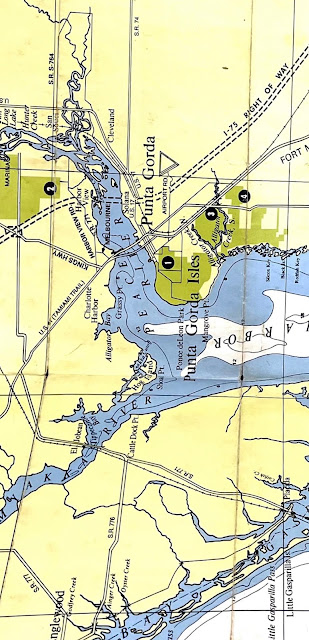The woman credited with being the mother of Punta Gorda’s tropical ambiance, Marian Ann Tyrrel McAdow, spent most of her adult life here. She was born Marian Wild at Put-in-Bay, South Bass Island, Lake Erie, Ohio on September 29, 1869. When she was a few weeks old, her father, overwrought with ten other siblings to care for, gave his baby daughter to a neighboring couple, Allen Terrell and his wife, who with their new child, moved to Escanaba, Michigan.
Marian had a life-long passion for horticulture, which she developed at the early age of five. But it was a chance meeting that enabled her to share it with Florida. While working as a school teacher in Chicago, she met Perry McAdow, the owner of the most productive gold mine in Montana history. They were married on October 2, 1897. He was to give her the opportunity to transform an area of Florida into a tropical paradise.
Soon after they were wed, Perry brought his pretty, young bride, 31 years his junior, to Punta Gorda where he was to become a prominent citizen, owner of one of the town’s earliest banks and a major influence on Punta Gorda’s development. He built for their home a huge mansion on filled-in submerged land right on Charlotte Harbor bay. (where the PG Waterfront hotel and Hurricane Charley’s is today).
Dismayed when she and Perry arrived in Punta Gorda by the lack of what she expected - a tropical jungle with swaying palm trees and other flowering plants, she set about to change that. She traveled to Europe, India, and the Caribbean talking to leading authorities on tropical landscapes and bringing seeds and plants to start her own beautiful garden and to help beautify Punta Gorda overall. Not only was she responsible for planting what is now the huge banyan on Retta Esplanade and the nearby jacaranda that flames red in May, she also drove the planting of the royal palms along Marion Avenue, though it’s said she would have preferred oaks draped with Spanish moss.
Known to thousands of readers of the Florida Grower as the “Ornamental Lady”, she influenced through her articles the creation of a tropical paradise throughout South Florida. Determined to turn as much of South Florida as she could into a blooming paradise, she and friend Sadie Farmington, drove around in her automobile distributing the seeds of beautiful plants. She also rewarded school children who helped with her mission.
Perhaps overshadowed by her horticultural achievements and recognition for being a prominent hostess, with her many dinner parties and yacht excursions, was her civic involvement and active role as a business woman. She took over the running of much of Perry’s business affairs after he died in 1918. It was said that had she not been a woman she would have probably been a Punta Gorda mayor. She was chair of the Board that developed a revised city charter and recommended to be the first city manager. She was also appointed by the Governor to the school board, a role she declined. She was a philanthropist who donated to many local causes and helped raise money for the high school and other community projects.
Marion also found time for the arts. She’s was the music director for the Episcopal Church, a good photographer and an accomplished artist. Many homes at the time had her paintings on their walls, although unfortunately none can be located today. Her photograph collection was lost in a fire.
In addition to Punta Gorda, Marion spent time at her home, RyxHaven, in the North Carolina Mountains. She died September 16, 1950 in Casey Key, Florida.
(As a footnote and sad commentary on women’s history, while there are many excellent pictures of Perry McAdow up until a few weeks ago only a few not very good photos of Marian could be found. Fortunately, a writer documenting the history of RyxHaven had a much better, younger portrait and shared it with us).
Picture Courtesy of Lawrence Newman and Susan Speight





















